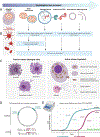Stress and circulating cell-free mitochondrial DNA: A systematic review of human studies, physiological considerations, and technical recommendations
- PMID: 33839318
- PMCID: PMC8418815
- DOI: 10.1016/j.mito.2021.04.002
Stress and circulating cell-free mitochondrial DNA: A systematic review of human studies, physiological considerations, and technical recommendations
Abstract
Cell-free mitochondrial DNA (cf-mtDNA) is a marker of inflammatory disease and a predictor of mortality, but little is known about cf-mtDNA in relation to psychobiology. A systematic review of the literature reveals that blood cf-mtDNA varies in response to common real-world stressors including psychopathology, acute psychological stress, and exercise. Moreover, cf-mtDNA is inducible within minutes and exhibits high intra-individual day-to-day variation, highlighting the dynamic regulation of cf-mtDNA levels. We discuss current knowledge on the mechanisms of cf-mtDNA release, its forms of transport ("cell-free" does not mean "membrane-free"), potential physiological functions, putative cellular and neuroendocrine triggers, and factors that may contribute to cf-mtDNA removal from the circulation. A review of in vitro, pre-clinical, and clinical studies shows conflicting results around the dogma that physiological forms of cf-mtDNA are pro-inflammatory, opening the possibility of other physiological functions, including the cell-to-cell transfer of whole mitochondria. Finally, to enhance the reproducibility and biological interpretation of human cf-mtDNA research, we propose guidelines for blood collection, cf-mtDNA isolation, quantification, and reporting standards, which can promote concerted advances by the community. Defining the mechanistic basis for cf-mtDNA signaling is an opportunity to elucidate the role of mitochondria in brain-body interactions and psychopathology.
Keywords: Mitochondria; Non-inflammatory effects; Psychosocial stress; Standard protocol; cell-free DNA; mtDNA.
Copyright © 2021 The Author(s). Published by Elsevier B.V. All rights reserved.
Figures






References
-
- Al Amir Dache Z, Otandault A, Tanos R, et al., 2020. Blood contains circulating cell-free respiratory competent mitochondria. FASEB J. 34, 3616–3630. - PubMed
-
- Anker P, Stroun M, Maurice PA, 1975. Spontaneous release of DNA by human blood lymphocytes as shown in an in vitro system. Cancer Res. 35 (9), 2375–2382. - PubMed
-
- Atamaniuk J, Vidotto C, Tschan H, Bachl N, Stuhlmeier KM, Müller MM, 2004. Increased concentrations of cell-free plasma DNA after exhaustive exercise. Clin. Chem 50 (9), 1668–1670. - PubMed
-
- Atamaniuk J, Stuhlmeier KM, Vidotto C, Tschan H, Dossenbach-Glaninger A, Mueller MM, 2008. Effects of ultra-marathon on circulating DNA and mRNA expression of pro-and anti-apoptotic genes in mononuclear cells. Eur. J. Appl. Physiol 104 (4), 711–717. - PubMed
-
- Aucamp J, Bronkhorst AJ, Badenhorst CPS, Pretorius PJ, 2018. The diverse origins of circulating cell-free DNA in the human body: a critical re-evaluation of the literature. Biol. Rev. Camb. Philos. Soc 93 (3), 1649–1683. - PubMed
Publication types
MeSH terms
Substances
Grants and funding
LinkOut - more resources
Full Text Sources
Other Literature Sources

